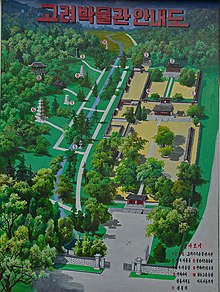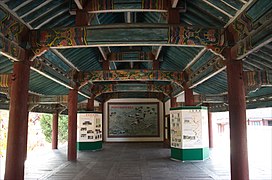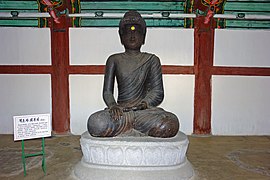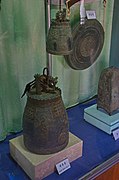Koryo Songgyungwan
Koryo Songgyungwan is a building complex in the city of Kaesŏng in North Korea . From the 11th to the 14th centuries it was the seat of the highest national educational institution in the Kingdom of Goryeo (Koryo). The building complex is registered as number 127 on the List of National Treasures of North Korea and is part of the World Heritage Site of Historic Monuments and Sites of Kaesŏng . It has housed the Goryeo Museum since 1987 .
location
The complex is located on the northeastern edge of the built-up area of Kaesong at the foot of Songak Mountain about two kilometers east of the Manwoldae palace district . To the west of the Koryo Songgyungwan site are the buildings of his successor organization, the Koryo Songgyungwan University , also known as the University of Light Industry.
history
In 992, King Seongjong from the Goryeo dynasty founded the state educational institution Gukjagam in the then capital Gaegyeong ( Kaesŏng ) . The academy was initially based in the south of Kaesŏng near the Hoebin Gate in the Outer Wall before moving into its final site in 1089. During the reign of King Munjong (1046-1083) there was a side castle, the Taemyong Palace. The castle building later served as a guest house until the Gukjagam moved into it. By 1367 the site was expanded to its present size.
After several renaming, the academy was called Songgyungwan from 1308 to 1358 and again from 1362 . The buildings of the complex were destroyed during the Imjin War (1592–1598). The buildings still standing today were reconstructed between 1602 and 1610 in the style of the Goreyo period. To distinguish it from the educational institution founded there after the capital was moved to Hanyang ( Seoul ) in 1398, which was also called Songgyungwan and from which Sungkyunkwan University later emerged, the building complex in Kaesŏng is called Koryo Songgyungwan .
description
The area of the Koryo Songgyungwan is about 140 meters long in north-south direction and about 80 meters wide in east-west direction. It is surrounded by a wall and divided into three parts, which are also separated from each other by walls.
The entrance to the complex is on the south. A gate with three passages leads into the lecture complex. On the east and west sides of a yard that is about 65 meters wide and 70 meters long and lined with trees is a 30-meter-long and 8-meter-deep single-storey building with a gable roof. These buildings used to be used by students as sleeping quarters. To the north of the courtyard, the Myongryun Hall stands on an elevated terrace about 45 meters wide and 20 meters deep, to which several stone steps lead up. From the entrance gate of the complex, a straight paved path leads to the central staircase. Myongryun is an open, single-storey hall with a floor plan of around 20 × 10 meters and a gable roof supported by round wooden columns. It served as a lecture hall. There are two smaller buildings next to the hall, in which Inzen and Confucian writings were kept.
Another gate with three passages leads through the wall at the rear end of the terrace into the shrine complex. Again a straight paved path leads to the middle of three stairs that lead up to an elevated terrace about 20 meters wide and 15 meters deep. On the terrace is the Taesong Hall, a closed single-storey hall with a floor plan of around 15 × 10 meters and an Irimoya roof. The hall serves as a shrine for ceremonies for the worship of Confucius. On the east and west side of the forecourt of the Taesong Hall, there are two 35 meter long and 4 meter deep single-storey shrines in which ceremonies for well-known Confucian scholars were held. In an extension of the shrine complex to the west stands the Kyesong shrine, which was only built in 1740 during the Joseon period.
To the west of these two complexes is an additional complex with buildings that were originally used to store equipment required for the ceremonies or to prepare ceremonies.
museum
Since 1987 the area of the Koryo Songgyungwan has been used as a historical museum for the Goryeo period. The Taesong Hall and several outbuildings serve as exhibition rooms.
The museum also has a park west of the Koryo Songgyungwan, in which pagodas , stupas , sculptures and lanterns from the time of the Koryo dynasty are set up, which were moved here from Kaesong and its surroundings.
literature
- Democratic People's Republic of Korea (Ed.): NOMINATION of THE HISTORIC MONUMENTS AND SITES IN KAESONG for Inscription on the World Heritage List . 2013, p. 51-59, 128 f., 164 f . (English, whc.unesco.org [PDF; 18.9 MB ] nomination letter).
Web links
Individual evidence
- ↑ Decision: 37 COM 8B.30. In: whc.unesco.org. UNESCO World Heritage Center, 2013, accessed July 4, 2020 .
- ↑ a b Kaesong Koryo Museum. In: North Korea Travel Guide. Koryo Tours, December 11, 2018, accessed July 26, 2020 .
- ↑ Nominations p. 53
- ↑ a b nomination p. 54
- ↑ a b nomination p. 55
Coordinates: 37 ° 59 ′ 30.2 ″ N , 126 ° 34 ′ 15.6 ″ E











